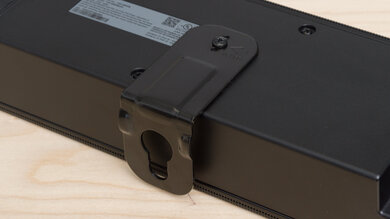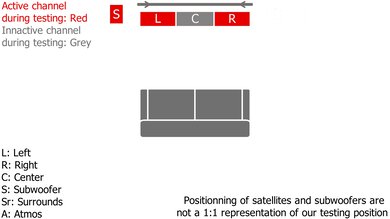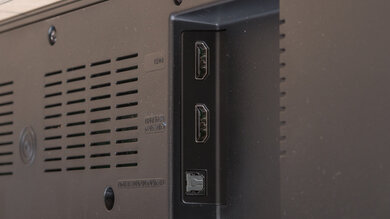The Samsung HW-Q600B is a mid-range setup released in 2022. The built-in Acoustic Beam technology is designed to improve its performance with height content like Dolby Atmos, which is commonly found on streaming platforms. As with most soundbars from the manufacturer, it's a highly customizable soundbar with lots of sound enhancement features, including a 7-band graphic EQ to change its sound across the range. It also supports Samsung's Q-Symphony technology, which allows you to pair the bar with a compatible Samsung TV to sync up the speakers. You can also add rear speakers if you want to improve its surround sound.
Note that our unit performs in a way that doesn't seem to align with expectations or with previous Samsung bars with similar features. This could be unique to our unit.
Our Verdict
The Samsung Q600B is good for mixed usage. Though it's advertised as a 3.1.2 bar, in our tests, audio didn't play from the up-firing or "Acoustic Beam" channels, so it performs more like a 3.1 setup. It shines with stereo content, including most music and TV shows, as dialogue and other instruments reproduce with clarity and accuracy. There are lots of customization tools on hand to adjust its output. However, we also had issues with the bar's surround channels. The right and left channels are silent when we try to play surround localization tones, so only the subwoofers play sound. This may impact your real-life listening experience, depending on how your television responds. If you have similar issues with your bar, please let us know in the discussions.
-
Graphic EQ.
-
Dolby Atmos support.
-
No sound from up-firing drivers.
The Samsung Q600B is great for dialogue-centric TV shows and podcasts. Thanks to its discrete center channel, vocal reproduction is clean and pure, and it's easy to follow along with the plot in your favorite shows. There's also a dialogue enhancement tool called Voice Enhance that's designed to make voices more crisp in the mix. When it comes to wireless connectivity, you're limited to Bluetooth, though.
-
Dialogue enhancement tool.
-
Bluetooth compatible.
-
No Wi-Fi, Apple AirPlay, or Chromecast compatibility.
The Samsung Q600B soundbar is satisfactory for music. Out of the box, its stereo frequency response accuracy is very good, especially in the mids where most voices and lead instruments are reproduced. Plus, it's customizable, with a 7-band graphic EQ available to help you switch up its sound to your liking. As a result, it's suitable for listening to a wide range of music genres. Fans of bass-heavy music like EDM and hip-hop may notice a touch less rumble in the low-bass, though.
-
Graphic EQ.
-
Gets loud.
-
Lacks a touch of low-bass.
-
No companion app.
The Samsung Q600B is decent for movies. The manufacturer advertises it to support lots of different audio formats that are commonly found on both streaming services and Blu-rays discs, from Dolby Digital to Dolby Atmos. With a discrete center channel, dialogue is clear and easy to follow, and the sub provides adequate rumble in action-packed scenes. That said, its up-firing drivers don't seem to play sound. Also, when we send surround localization tones to the bar, the left and right surround channels are silent. Only the subwoofer plays audio, which is unusual behavior.
-
Graphic EQ.
-
Dolby Atmos support.
-
No companion app.
-
No sound from up-firing drivers.
- 7.4 Mixed Usage
- 8.1 Dialogue/TV Shows
- 7.4 Music
- 6.9 Movies
Changelog
- Updated Jan 09, 2024: Updated results in Video Passthrough to TV box after confirming that the bar's real-life performance doesn't match our Murideo results.
- Updated Dec 19, 2023: Added market comparison with the Samsung HW-Q600C/Q60CC in the Stereo Frequency Response box.
- Updated Jul 05, 2023: Converted to Test Bench 1.2. Updated the results for audio format support via ARC/eARC, HDMI In, and Optical. Added Video Passthrough to TV results as well.
- Updated Mar 27, 2023: Added cable lengths to In The Box.
- Updated Mar 22, 2023: Converted to Test Bench 1.1. With this update, we've added a Mounting test and added information aboutSubwoofer Output, Spotify Connect, and Microphone Mute.
Check Price
Differences Between Sizes And Variants
The Samsung HW-Q600B is available in Black, and you can see the label for the model we tested here.
If you come across another version of this soundbar, let us know in the discussions.
Compared To Other Soundbars
The Samsung HW-Q600B is the next generation of the Samsung HW-Q600A. Like its predecessor, the manufacturer advertises that it supports Samsung's Acoustic Beam technology for a more immersive listening experience. For the price, it offers a lot of customization features to switch up its sound to your liking. However, depending on how your television responds, you may notice some issues with surround sound. In our tests, surround localization tones don't play from the left or right surround channels, so only the subwoofer is active. It's unusual behavior, and it could prevent you from hearing some details in the mix.
You can also check out our recommendations for the best soundbars, the best Dolby Atmos soundbars, and the best soundbars with a subwoofer.
The Samsung HW-Q600C/Q60CC is the next generation of the Samsung HW-Q600B. These bars have similar setups and a similar selection of sound enhancement features. However, the next-generation model is the better performer. The Q600B incorrectly implements many audio formats, resulting in a less life-like sound. The Q600C has a better surround sound performance, too. Our results with the Q600B were quite unusual, though, and it's possible that they represent a defect in our unique unit rather than the typical performance of this soundbar.
The Samsung HW-Q600B and the Samsung HW-B650 are both 2022 releases from the manufacturer. The main difference between these two bars comes in support for height content like Dolby Atmos, which is often found on different streaming platforms. The Q600B supports height content, while the B650 doesn't.
The Samsung HW-Q600B is the next generation of the Samsung HW-Q600A. They're both similar bars, advertised to support a similar selection of features. With stereo content, they sound similar, too. However, even though the Q600B is also advertised as a 3.1.2 setup, its up-firing drivers don't play any sound with height content. We aren't sure if this issue is unique to our unit or not at this time.
The Samsung HW-Q600B and the Sonos Arc each have different strengths and weaknesses. The Samsung has a dedicated subwoofer, bringing a little more rumble in the bass. It also has more sound enhancement features and a Full HDMI In port for video passthrough. However, the standalone Sonos offers a better stereo soundstage, and you can always upgrade it with a sub and satellites to improve its sound.
The Samsung HW-Q800B is better than the Samsung HW-Q600B. The Q800B is a 5.1.2 setup that comes with two additional channels for surround sound. Its soundstage performance is better, too, and it brings a little more rumble in the low-bass. Plus, it supports more premium features like room correction, so its audio reproduction adjusts to the unique acoustics of your room.
Depending on your listening habits, you may prefer either the Samsung HW-Q59CT or the Samsung HW-Q600B. The Q59CT is a 5.1 soundbar, meaning that it comes with two additional channels for surround sound. It has a better surrounds performance, naturally. However, it doesn't support height content like Dolby Atmos. If you watch a lot of Atmos content, the Q600B is likely the better choice, even though its advertised up-firing channels didn't work on our unit, and it has to play height content through its side-firing drivers instead.
Test Results
The Samsung HW-Q600B is a simple soundbar with a similar design to the Samsung HW-Q67CB. It's mostly made of plastic, and there's a metal grille covering the top and the front. The sides of the bar are angled, too.
While the bar doesn't have rear satellites included, you can buy a compatible Wireless Rear Speaker Kit from the manufacturer.
The Samsung HW-Q600B has good build quality. Overall, its materials feel solid and sturdy. The plastic bar has metal grilles on the top and the front to help protect the drivers inside, which is a nice touch. That said, the fabric covering the front of the sub is loose and thin, so you should be careful when moving the sub to avoid ripping the fabric.
The Samsung HW-Q600B has a very good stereo frequency response. Out of the box, its sound profile is rather balanced, especially in the mids, where most voices and lead instruments are reproduced. As a result, it's suitable for listening to most music genres. If you prefer bass-centric music like EDM and hip-hop, you'll notice that the bar doesn't reproduce as much low-bass as others we've tested, like the Samsung HW-Q800B.
During our tests, we ran into several issues that may impact the bar's sound. First, we tried to update the bar to the latest firmware version 1014.0 with multiple USB flash drives, but the bar wouldn't read the file. Secondly, in our stereo tests, the bar exhibited some strange behavior. The localization files usually play on either the left or right stereo channels, but with this bar, sound was audible from both the left and right stereo channels at the same time. The behavior is hard to hear with real-life content, but it could impact the localization of objects in the soundstage. For all of these issues, we aren't certain whether they're unique to our unit or whether you're likely to run into them as well. Please let us know in the forums if you have similar issues. You can also check out the Samsung HW-Q600C/Q60CC if you want a similar bar without these issues.
If you prefer a more balanced sound with stereo content, we recommend using the bar with its default settings.
The Samsung HW-Q600B's soundstage is decent. It's perceived to be about as wide as the bar itself, but it doesn't have any tricks to make it seem larger than that. Still, it has good focus, so sound effects like instruments seem to come from accurate, pinpoint locations in the soundstage.
The Samsung Q600B gets loud enough to fill larger and more open spaces with sound. At max volume, there are some compression and pumping artifacts present, which affect the overall clarity of audio reproduction.
The Samsung HW-Q600B's stereo THD performance is decent. At a normal listening volume, distortion falls within good limits, so audio reproduction is clean and pure. As with most bars, there's a jump in THD when the bar's pushed to max volume. However, distortion is hard to hear with most real-life content, so it's not a huge issue unless you're a very astute audiophile.
This 3.1 soundbar comes with a discrete center channel to improve vocal reproduction. It offers great performance, with a balanced frequency response that ensures voices are clearly and accurately reproduced in the mix.
In comparison with other soundbars like the Samsung HW-Q600A, this bar's surround performance is unusual. When we send surround localization tones to the bar, audio only comes from the subwoofer, while the right and left channels are silent. This is exemplified by the unique shape of the frequency response graph since the only sound comes from the lower frequencies played by the subwoofer itself.
When the bar is plugged into a TV via eARC to play real-life content, however, sound plays from the right and left channels in addition to the subwoofer. The TV may be downmixing the surround content, rather than the bar itself. Let us know in the discussions if you experience similar issues with this soundbar.
The Samsung Q600B is advertised as a 3.1.2 setup with two up-firing channels built into the top of the bar. Unlike the Samsung HW-Q600A, however, the bar's up-firing channels don't play any sound with Atmos content. Instead, audio comes from the two front-firing channels.
Subjectively, the bar's Atmos performance is noticeably better than listening to content with only TV speakers. Thanks to the dedicated subwoofer, there's a good amount of rumble in action-packed scenes. Details are clearly reproduced, as exemplified by the balanced frequency response. That said, you don't get an immersive feel, as the bar struggles to make it seem like audio is coming from above you or around you.
The Samsung HW-Q600B supports lots of different sound enhancement features. While it doesn't have a room correction feature like more premium models on the market, you can still adjust its audio reproduction based on your room's acoustics using its graphic EQ and presets. Modes like Surround Sound, Standard, Game Pro, and Adaptive Sound let you adjust the bar's sound to your liking. If you add on rear speakers, you can adjust the rear levels.
As with many soundbar and TV manufacturers, Samsung advertises a feature that's designed to improve audio reproduction when the bar is paired with a compatible Samsung TV. It's called Q-Symphony, and it syncs the bar's speakers with your TV speakers. In practice, we found that this feature increases the volume, but otherwise, it doesn't make much of a difference in the sound quality. As with most of these features, it's not necessary to enjoy content with your soundbar.
You can connect this bar to your TV using HDMI or Optical connections. There's a Full HDMI In port, which lets you use the bar as a hub between different devices, like when you want to passthrough high-quality video.
The Samsung HW-Q600B supports many different audio formats that are commonly found on both streaming platforms and Blu-rays discs. In our tests, we use a Murideo HDMI testing device to confirm audio support, and it appears that the bar can playback these formats. However, in practice, when we try to play the left and right surround localization tones, no sound plays from the left or the right channels. The behavior is unusual, and at this time, we can't confirm whether it's unique to our testing unit or not. Please let us know in the forums if you experience any similar issues.
The bar's surround channels exhibit the same strange behavior via HDMI In. While it appears to support many different audio formats, when we send surround localization tones to the bar, we only hear audio through the sub, while the left or right surround channels are quiet. Again, let us know if you have similar issues in the discussions.
We also tried to send surround localization tones to the bar via Optical, and it exhibited the same unusual behavior as it did over eARC and HDMI In. The left and right surround channels are quiet, and sound is audible only from the subwoofer.
The bar has relatively low latency, so it's a good choice for watching videos and movies. Since audio appears in sync with the video you see, you don't notice any lip-synching issues. Of course, some apps and TVs compensate for latency differently, so your real-world experience can vary. If you have any issues, the bar's Audio Sync feature lets you control the delay manually, which is handy.
This soundbar can passthrough some common refresh rates and resolutions. Our Murideo device says that it can passthrough 1080p at 120 Hz, but as with the Samsung HW-Q600C/Q60CC, this isn't in line with the real-world performance of the bar. When connected to PCs, consoles, and various brands of TVs, the bar can only do 1080p @ 60Hz. Let us know in the forums if you run into the same issue.
You can wirelessly stream audio to the bar from your mobile devices via Bluetooth. Plus, the bar supports Tap Sound, so you can simply "tap" certain compatible Samsung phones against the bar to mirror audio to the bar.
Comments
Samsung HW-Q600B: Main Discussion
Let us know why you want us to review the product here, or encourage others to vote for this product.
Update: Updated results in Video Passthrough to TV box after confirming that the bar’s real-life performance doesn’t match our Murideo results.





































